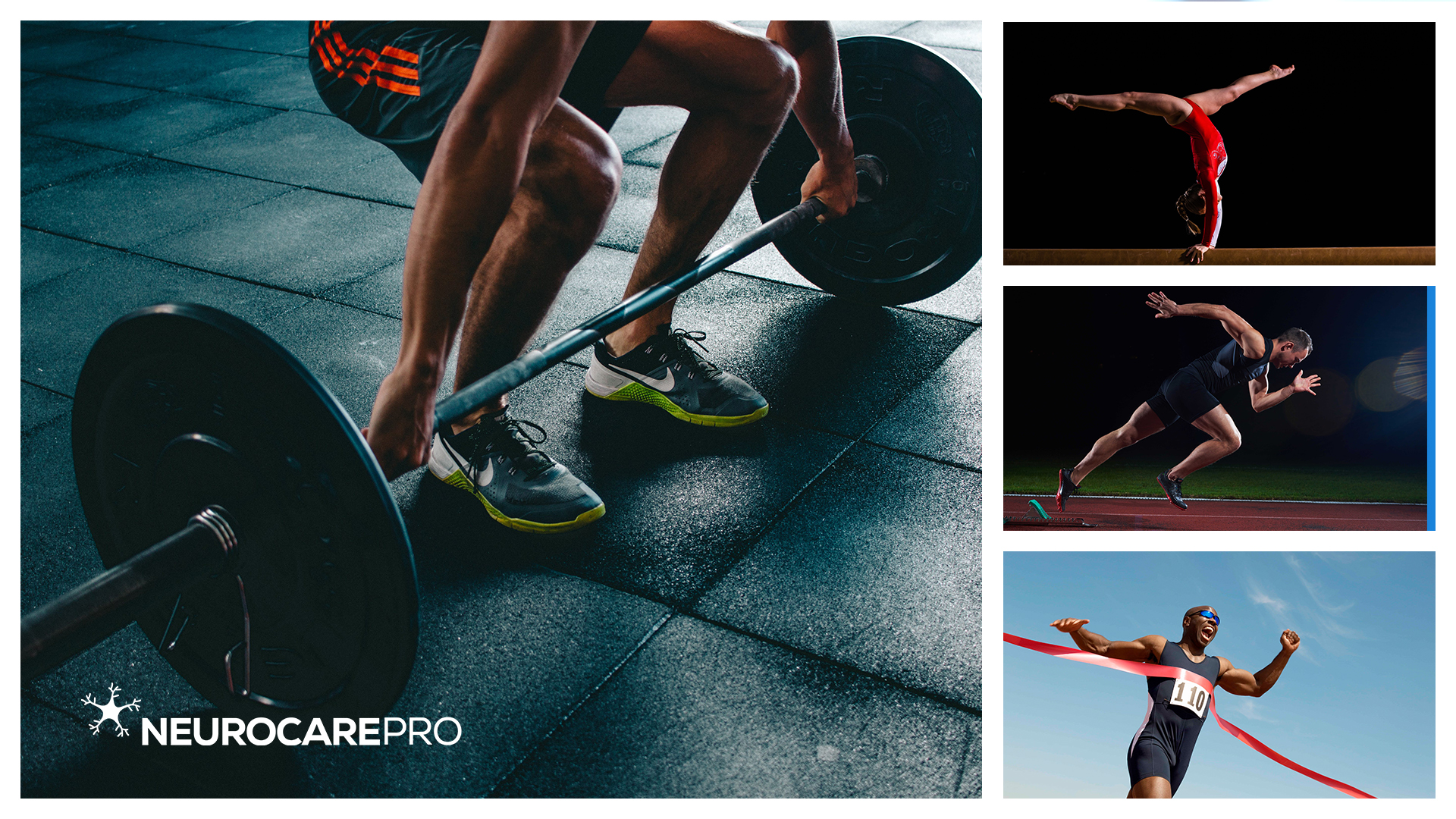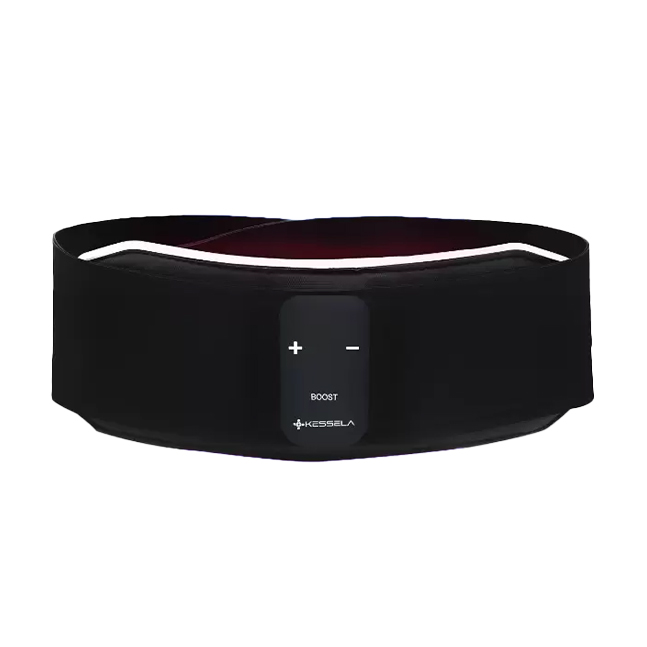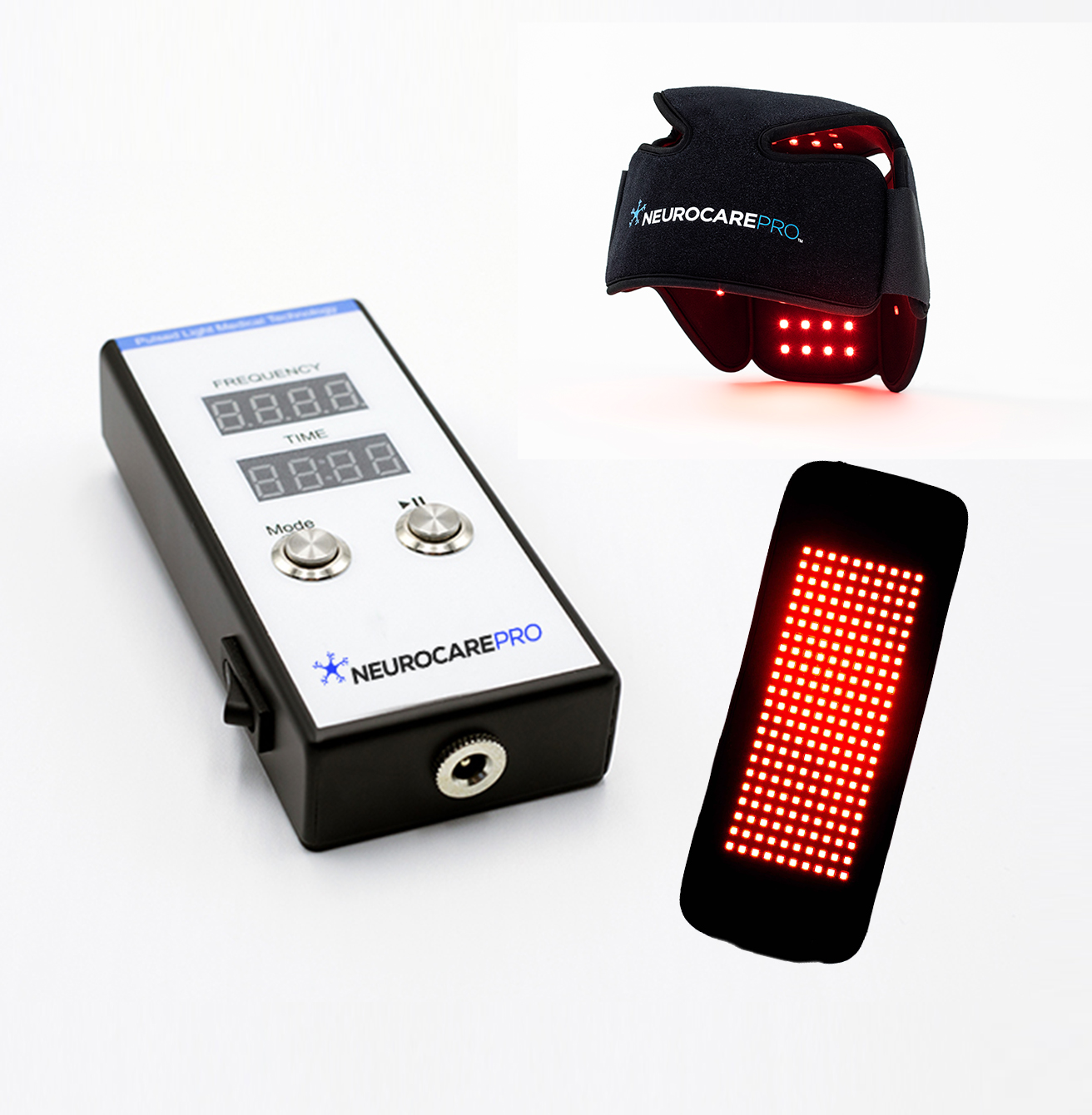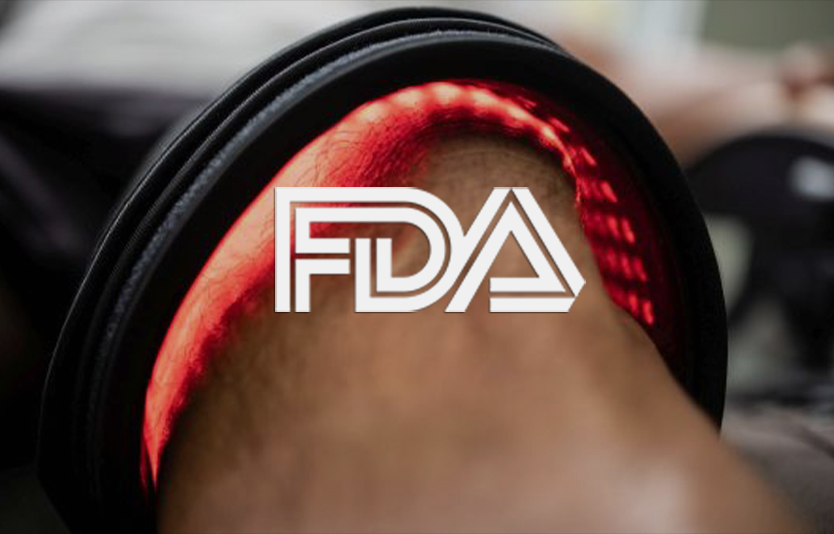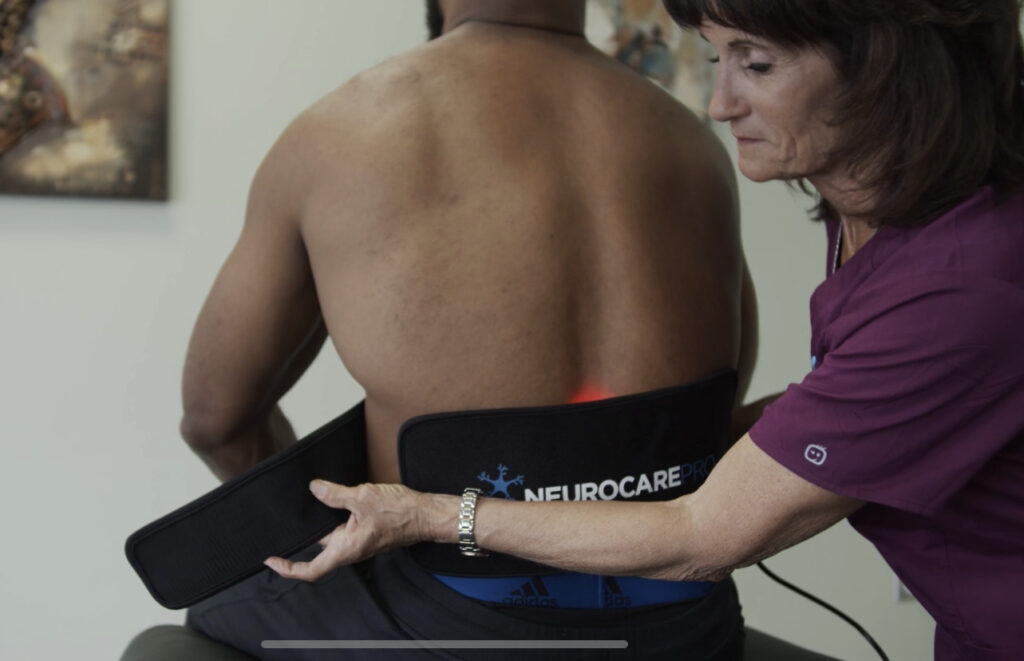Boost Performance & Recovery
By leveraging a polychromatic spectrum of both red light and Near-Infrared (NIR) wavelength nanometers and advanced mechanisms of pulsed targeted frequencies, PLMT offers significant advantages over traditional Red Light Therapy (RLT) and Near-Infrared (NIR) therapy in promoting athletic recovery. This is primarily due to its use of pulsed polychromatic light. This approach allows PMLT to deliver a broader spectrum of wavelengths, including Red Light Therapy (RLT) and Near Infrared Therapy (NIR) simultaneously, which can enhance therapeutic outcomes. These differences include:
1. Light Source and Wavelengths:
- PLMT: This therapy utilizes polychromatic light, meaning it emits multiple wavelengths simultaneously. This broad spectrum can include various colors of light, which are believed to penetrate tissues differently and target various cellular processes. Neurocare Pro’s exclusive technology delivers polychromatic light for optimal tissue penetration – up to 5 wavelengths simultaneously 650nm, 810nm, 850nm, 950nm, 1040nm, 1070nm.
- RLT/NIR LLLT: These therapies primarily use monochromatic light, which means they emit a single wavelength (typically red or near-infrared). Common wavelengths for RLT are around 600-650 nm, while NIR often ranges from 800-900 nm.
2. Delivery Method:
- PLMT delivers light in pulses, which can enhance the biological response by providing intervals of rest for cells, allowing them to process the absorbed energy more effectively.
- RLT/NIR LLLT typically delivers continuous light, which can lead to thermal effects and may not provide the same level of cellular activation.
This has many advantages over traditional forms of Red Light Therapy in a myriad of ways:
- Polychromatic Light Delivery: PMLT utilizes pulsed polychromatic light, meaning it emits multiple wavelengths at once, unlike standard RLT/NIR devices, which typically use a single monochromatic wavelength. This broad spectrum can penetrate tissues more effectively, targeting multiple biological mechanisms simultaneously.
- Simultaneous Application: By combining RLT and NIR, PMLT can address both surface and deeper tissues, optimizing treatment for conditions that involve both superficial and deeper neurological and physiological processes.
- Enhanced Cellular Response: The pulsed nature of PMLT allows cells to absorb energy in intervals, promoting better energy utilization and reducing the risk of thermal damage. This can lead to improved cellular metabolism, increased ATP production, cell proliferation, overall metabolic functions, and enhanced healing processes.
- Enhanced Tissue Penetration: Polychromatic light in PLMT can penetrate deeper into tissues compared to monochromatic light, potentially affecting deeper cells and structures.
- Reduced Risk of Thermal Damage: The pulsed nature of PLMT minimizes the risk of overheating tissue, making it safer for sensitive areas.
- Broader Therapeutic Applications: The versatility of polychromatic light allows PLMT to be effective for a wider range of conditions, including those involving different tissue types and depths.
- Improved Blood Flow: PLMT has been shown to enhance local blood circulation more effectively than continuous light therapies, which can aid in recovery and tissue regeneration.
Research shows that this stimulation can enhance cellular processes, offering a range of benefits for athletic performance and recovery. By stimulating cellular activity and increasing blood circulation, this non-invasive and safe treatment helps reduce muscle fatigue and speeds up the healing of tissue injuries. Here are some of the ways PLMT therapy can enhance an athlete's performance and recovery:
- Multi-Wavelength Application: PLMT utilizes a combination of multiple wavelengths, allowing for simultaneous targeting of various tissues and systems within the body. This multi-faceted approach enhances the recovery process by addressing muscle soreness, inflammation, and tissue repair more effectively than standard RLT/NIR devices, which typically operate at a single wavelength.
- Deep Tissue Penetration: One of the notable features of PLMT is its ability to penetrate up to 11 inches deep into the tissues. This capability enables it to reach muscles, tendons, and ligaments, facilitating recovery from injuries and reducing muscle soreness (Borisov et al., 2019).
- Enhanced Mitochondrial Function: PLMT significantly boosts mitochondrial function, leading to increased ATP production. Enhanced ATP levels provide the energy necessary for muscle repair and recovery, making it a vital tool for athletes seeking to optimize their performance (Wang et al., 2018).
- Reduction of Inflammation: Inflammation is a common response to intense physical activity and injury, often hindering recovery. PLMT effectively reduces inflammation by modulating inflammatory pathways, creating a favorable environment for healing and allowing athletes to return to their training regimens more quickly (Fitzgerald et al., 2019).
- Improved Circulation: The pulsed nature of PLMT stimulates microcirculation, which enhances blood flow to the treated areas. Improved circulation delivers essential nutrients and oxygen to muscles and tissues, promoting faster recovery and reducing soreness (Tavakoli et al., 2020).
- Pain Management: PLMT has been shown to have analgesic effects, helping to alleviate pain associated with injuries and muscle fatigue. By reducing pain, athletes can engage in rehabilitation exercises more comfortably, further supporting their recovery process (Meyer et al., 2021).
- Solfeggio and Nogier Frequencies: The incorporation of pulsed frequencies, such as Nogier and Solfeggio frequencies, enhances the healing mechanisms of PLMT. These frequencies improve cellular communication and can amplify the body’s natural healing responses, further benefiting athletic recovery (Peters et al., 2021).
Boost Performance & Recovery
Pulsed Light Medical Technology (PLMT) therapy harnesses the power of combined multiple red and near-infrared light wavelengths with targeted pulsated frequencies, which are particularly effective in penetrating deeper into the tissues than traditional monochromatic red light therapy. Research shows that this stimulation can enhance cellular processes, offering a range of benefits for athletic performance and recovery. Here are some of the ways Pulsed Light Medical therapy enhances an athlete's performance and recovery:
- Comprehensive Recovery Solution: PLMT's ability to target various tissues and systems simultaneously allows for a more effective recovery regimen, addressing multiple aspects of athletic performance and recovery, including muscle soreness, inflammation, and tissue repair.
- Muscle Recovery: Red light therapy is known for its ability to reduce muscle soreness and fatigue. This treatment can increase the production of ATP (adenosine triphosphate), which helps muscles recover faster after intense physical activity. This means athletes can train harder and more frequently.
- Injury Healing: Injuries, such as strains and sprains, can be treated effectively with red light therapy. It accelerates cell repair and increases blood circulation, reducing recovery time and getting athletes back in action sooner. Source: Lasers in Medical Science
- Reduced Inflammation and Pain: Red light therapy can help reduce inflammation and alleviate pain, making it an excellent option for managing chronic conditions like tendonitis or acute injuries like muscle sprains. By lowering inflammation, red light therapy facilitates a quicker return to training.
- Enhanced Blood Flow: By increasing circulation, red light therapy ensures that more oxygen and nutrients are delivered to muscle tissues, which is crucial for recovery and performance. Improved blood flow also helps in flushing out waste products such as lactic acid, reducing muscle cramps and stiffness.
- Faster Recovery Times: The enhanced mitochondrial function and reduced inflammation associated with Pulsed Light therapy (PLMT) lead to quicker recovery times compared to standard therapies, enabling athletes to resume training and competition sooner (Zhou et al., 2020).
- Improved Performance: By facilitating faster recovery, PLMT helps athletes maintain their training schedules and improve overall performance, reducing the risk of injury and enhancing competitive edge.
- Boosted Energy Levels: Studies suggest that red light therapy can influence the mitochondria, the powerhouse of the cell, thereby increasing energy levels which are beneficial for athletes who need sustained energy for long periods. Source: European Journal of Applied Physiology
- Mental Acuity: There's emerging evidence that red light therapy could also help in improving mental alertness and reducing stress, which can be particularly beneficial before a competition. Source: Neuroscience
- Versatile Applications: PLMT can be used for a range of athletic injuries, including strains, sprains, and muscle soreness, making it a versatile addition to any athletic recovery program.
- Preventative Benefits: By enhancing mitochondrial function and circulation, PLMT not only aids in recovery but also helps prevent future injuries, making it an effective tool for long-term athletic health (Meyer et al., 2021).
Pulsed Light Medical Technology represents a significant advancement in athletic recovery modalities. Its ability to penetrate deeply, stimulate mitochondrial function, reduce inflammation, and enhance overall recovery makes it a superior choice compared to traditional RLT and NIR therapies. With its multifaceted approach, PLMT stands out as a powerful solution for athletes seeking to optimize their recovery and performance.
Implementation in Athletic Training:
Given these benefits, integrating PLMT therapy into an athletic training regimen could be straightforward:
- Set up a dedicated therapy room or portable devices for on-site or field use.
- Schedule regular sessions post-training for recovery, pre-competition for energy enhancement, and post-injury for accelerated healing.
- Educate athletes and coaching staff on the benefits and safe usage of PLMT pulsed light therapy.
Athletes and trainers looking to gain a competitive edge and improve recovery times should consider exploring red light therapy as a scientifically backed addition to their wellness protocols.
Further Reading and Research:
Explore more about polychromatic pulsed red light/NIR therapy and its applications in sports through these sources:
As always, consult with sports medicine professionals to tailor your PLMT, polychromatic pulsed red light and NIR light therapy, appropriately to individual athlete needs and ensure it complements other treatments and training protocols effectively.
References:
- Borisov, I., Shcherbakov, A., & Ivanov, A. (2019). Photobiomodulation and fibroblast function in skin rejuvenation: A systematic review. Journal of Cosmetic Dermatology, 18(1), 20-28. Accessed from: https://onlinelibrary.wiley.com/doi/full/10.1111/jocd.12600
- Fitzgerald, M., Gorman, M., & Raghavan, S. (2019). The role of light therapy in the management of skin inflammation: A review. Dermatology Research and Practice, 2019, 1-10. Accessed from: https://www.hindawi.com/journals/drp/2019/7561118/
- Meyer, S., Riedel, S., & Huber, R. (2021). The impact of photobiomodulation on skin health: A clinical overview. Clinical, Cosmetic and Investigational Dermatology, 14, 663-674. Accessed from: https://www.ncbi.nlm.nih.gov/pmc/articles/PMC8199686/
- Peters, H., Wiegand, C., & Schenk, H. (2021). The role of frequency modulation in photobiomodulation therapy: A review. Lasers in Medical Science, 36(2), 239-245.Accessed from: https://link.springer.com/article/10.1007/s10103-020-03057-5
I've been using Neurocare's pulsed light products for years with spectacular results so my expectations were already pretty high when I purchased the MedMask pro and MedMat pro. Even so, I was blown away at how nice these products are. The design improvements are impressive, but most of all, I can see and feel improvements in my body after only using them for a week. I happened to be sick when I first received the Medmat, and laying on it gave me so much relief! I know it sped up my recovery time.

